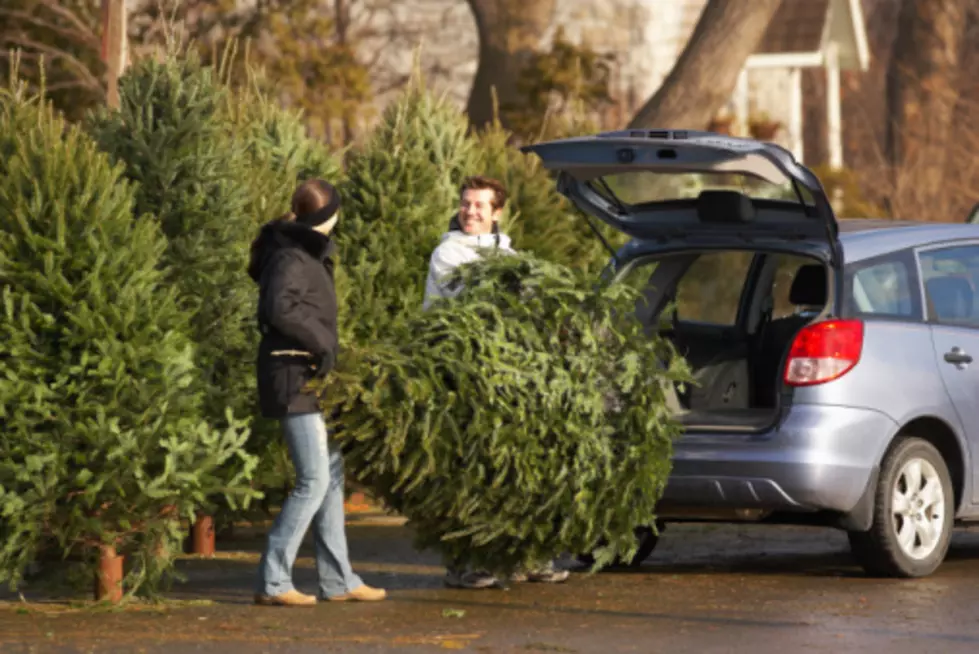![The Great Christmas Tree Debate: Real vs. Fake? Round 2 [POLL]](http://townsquare.media/site/385/files/2013/12/rays-tree-300x300.jpg?w=980&q=75)
The Great Christmas Tree Debate: Real vs. Fake? Round 2 [POLL]
Every year I run down to the basement and lug up the stairs the bulky bag that contains the Scotch Pine artificial Christmas tree I bought I don’t know how many years ago at an after-Christmas sale.
It still looks good to me – even though the color-coded branches are worn and it takes some guesswork to figure out which branch goes into which hole.
But I never have to worry about upkeep.
How long is it going to last? As long as the tree still stands upright and the angel on top doesn’t look like she’s going to tip over.
I’m already past the point of thinking I need to get a real tree.
However, you’d never think so what with the way I was brought up.
Back in the day, you could go to any street corner grocery store and pick out a tree from a group lying up against the side of the store.
And there was nothing like walking through that column of trees, smelling the pine scent and feeling the sticky pine sap on each and every branch.
But that was then – at least for me.
I’ve gotten lazy over the years – however it’s somewhat gratifying to see that there are still a number of you who make a trek out to any of the dozens of Christmas tree nurseries to get a real one.
And this past weekend there was no shortage of cars with trees attached to their roofs.
Makes me feel guilty in a way.
Black Friday marked the de facto start of the season for New Jersey’s Christmas tree growers, who will sell about 80,000 trees from now through Christmas, said Lynne Richmond, spokeswoman for the state Department of Agriculture.
Christmas trees have been an agricultural staple in New Jersey since 1901, when Mercer County farmer W.V. McGalliard planted 25,000 Norway spruces outside Trenton, creating what is believed to be the first such farm in the United States.
A century later, New Jersey is still among the top-ranked producers in an industry in which Americans spent more than $1 billion last year, according to a 2012 market survey by the National Christmas Tree Association.
New Jersey was 15th in the nation in total trees harvested, according to the U.S. Department of Agriculture’s 2007 census, the most recent one available. Census data for the 2012 season will be released in February.
This year, the state’s growers will benefit from a push by Gov. Chris Christie, who proclaimed Dec. 2 as New Jersey Grown Christmas Tree Day, with the hopes of encouraging residents to support their local farmers.
It seems residents need little encouragement, though. While many industries have suffered in the ongoing recession, New Jersey Christmas Tree Growers’ Association Executive Secretary Donna Cole said many businesses she knows have flourished, including her own.
Americans bought 24.5 million live trees last year, according to the National Christmas Tree Association. This is a drop of about 6 million from the previous year. About 11 million artificial trees were sold in 2012.
While putting up an artificial tree is certainly easier than picking a fresh one, for those who make it a tradition of getting a live tree, there’s no substitute.
Seaville resident Jenny Polo and her family grabbed breakfast at Dino’s Diner early on Black Friday before driving to Littleworth to pick their tree. They’ve done it for years and will do it again, she said, because it’s a holiday experience like nothing else.
“It’s just better when it’s cold,” she said. “It’s bundling up and getting everybody out here, running through the trees and touching them. It’s sensory.”
Still, for me it’s still about the convenience of not having to care for the tree and about not having to worry about the possible fire hazard.
But if you do go for the real tree, according to this, here’s what you should be looking for:
Retired New Jersey State Forester Les Alpaugh of Evergreen Valley Christmas Tree Farm in Washington knows a thing or two about trees.
While Les has heard many stories on how people care for trees including adding aspirin, sugar and Clorox bleach to water. Alpaugh insists that all the tree really needs is plain water, and lots of it. In fact, if you leave the tree without water for too long, it can seal up and stop drinking which can lead to the tree drying out and dropping needles prematurely.
Also, when you bring your tree home, it's important to make a fresh cut at the base of the tree and place it in a tree stand with plenty of water. The tree will absorb more water initially so keep an eye on it and add water often. Cared for properly, your tree can last more than four weeks.
So which do you prefer: buying a real Christmas tree or buying an artificial one?
More From New Jersey 101.5 FM









